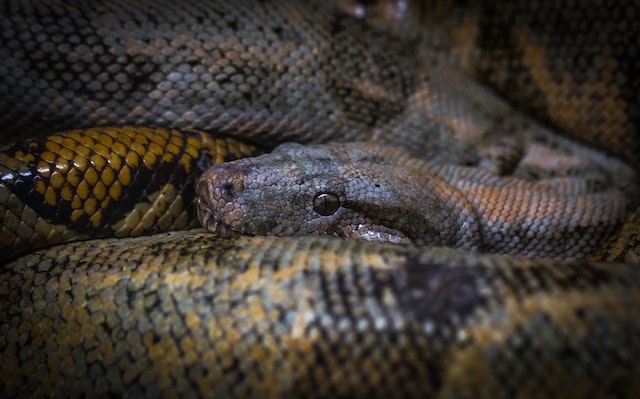
How do pythons kill their prey? They squeeze their prey to constrict blood flow before consuming the prey whole.
Before we start, pythons are not boa constrictors. I always thought they were the same thing, but they aren’t. Pythons are longer than boa constrictors and they come from different areas. Boa constrictors are found in North and South America, while pythons come from Africa, Asia, and Australia. Pythons also have more bones in their heads, and they have an upper jaw with teeth. Boa constrictors give birth to live young while pythons lay eggs. However, they both kill their prey by constricting it.
There are 39 different species of python around the world. The smallest pythons are about 60 cm long and weigh about 200 g. The biggest pythons are about 11 m long and weigh about 120 kg. They often hide in trees and can hang onto branches. They aren’t venomous, so they kill their prey in a different way.
Pythons are ambush predators. They hide and wait for prey to come along. They can only move at about 1.5 km/h, so they cannot chase anything. They have holes along their jaws near to each nostril that allow them to sense heat. These holes have a membrane that produces an electric signal when it is excited by a temperature change, called a pyroelectric effect. The snake can detect a temperature change up to 40 cm away in less than half a second.
Snakes obviously go for prey that befits their size. Small pythons go for small prey and large pythons go for large prey. When the python detects prey, it darts forward and grabs the prey with its teeth. Pythons have six rows of sharp teeth that point backwards. Once the python has bitten into its prey, the prey cannot wriggle free.
Then the python wraps itself around the prey. For years, people experts thought that this was to stop the prey being able to breathe, but it turns out that they do it in order to shut the prey’s circulation down. There are three reasons for this. The first is that death by asphyxiation takes longer than death by circulatory arrest. When a python is killing its prey, it has to use a lot of energy and the faster it can kill its prey, the better. The second reason is that the python is very exposed to danger while it is killing its prey. The faster the better. The third reason is that some animals can actually survive for a long time without breathing. Some lizards can go up to four hours without breathing. If the python was trying to asphyxiate them, it wouldn’t work.
Experiments have shown that when the python wraps itself around its prey and begins to squeeze, the blood pressure in the animal’s arteries falls and the pressure in its veins rises. Arteries carry blood away from the heart and the veins carry it back. This means that the python’s prey’s heart doesn’t have enough strength to get blood back to the heart for oxygenation. The heart rate goes crazy, blood supply is shut down, and the organs and brain can’t get oxygen, which means they stop working pretty quickly.
Squeezing an animal requires a lot of strength and energy, so pythons don’t want to be doing it for any longer than is necessary. Pythons are able to sense the vibrations that come out of their prey with each heartbeat. They increase pressure so long as the heart is beating and then relax pressure shortly after the heart has stopped beating.
Once the prey is dead, the snake goes ahead and eats it. Snakes don’t have teeth to rip and chew, so they swallow the animal whole. Snakes can generally open their mouths four times as wide as their body. As they swallow their prey, they have glands in their mouths that secrete digestive justices that start to break the prey down. They don’t have any muscles in their esophagus, so they swallow the food by basically walking their body forwards over the food. In their stomachs they have strong muscles that press in on the food and very strong digestive enzymes that can digest even the bones and the teeth of the prey. They absorb all of the energy and, depending on the size of the snake and the prey, a python only needs to eat about once every two weeks. And this is what I learned today.
Sources
https://www.sjsu.edu/serc/docs/snakes-curriculum/Lesson%202%20-%20Digestive%20System-1.pdf
https://www.ck12.org/book/ck-12-biology-advanced-concepts/section/16.27/
https://www.scientificamerican.com/article/snakes-flexible-heat-sensing-organs-explained/
https://sdzwildlifeexplorers.org/animals/python
https://en.wikipedia.org/wiki/Pythonidae
https://thewire.in/environment/how-do-snake-constrictors-kill-their-prey
